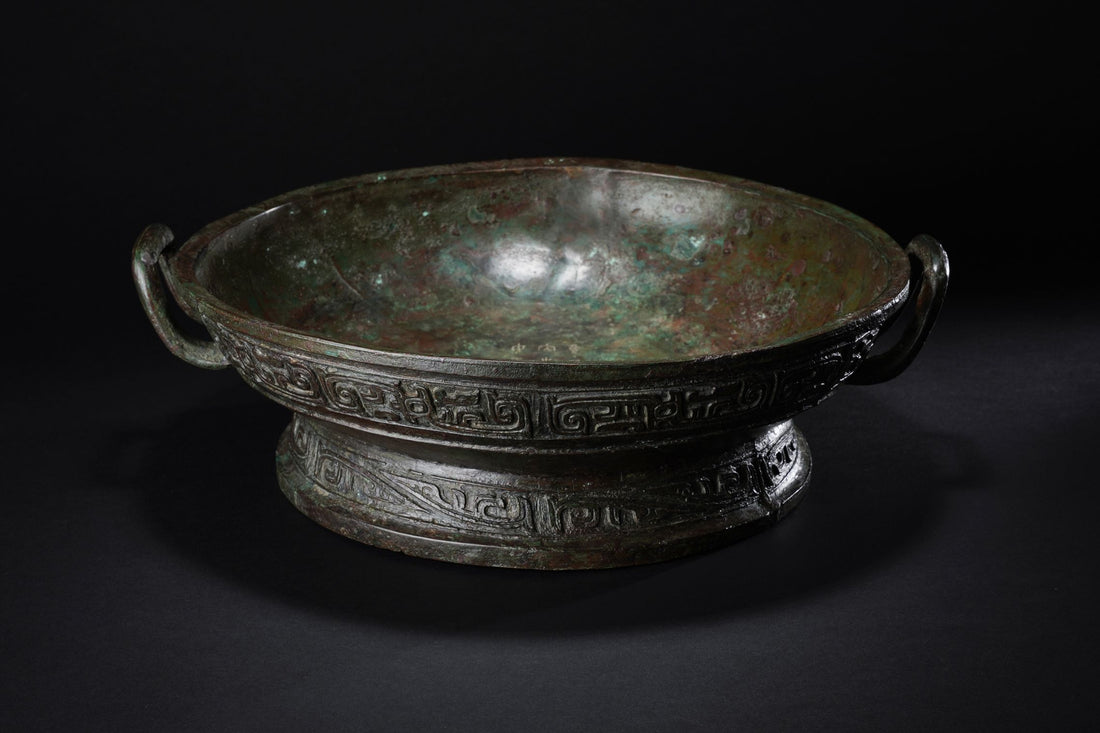
Double Ears Transforming into Dragon Mian bowl

This double-handled dragon-Mian bowl is from the Western Zhou Dynasty, with 33 characters inscribed on it.

Most of the ancient bronze water vessels were used for washing, so they are also called wash vessels. They can be roughly divided into four types: water holders, water injectors, water containers, and water scoops. They include plates, basins, mirrors, pots, etc. Bronze plates are one of the most common water vessels in museums and belong to water holders. Before the Shang Dynasty, plates were made of pottery. Bronze plates appeared in the early Shang Dynasty, but in small quantities. Bronze plates gradually became popular in the late Shang Dynasty. Most bronze plates between the Shang and Zhou Dynasties had no ears and ring feet. After the Western Zhou Dynasty, they began to have ears, and some had spouts and handles.

Why is "Zhou" written above the word "Pan"? This starts with the word "皿". "Shuowen Jiezi" records that "皿" is "a vessel for eating." It refers to a vessel for holding rice. When writing, the ancients often wrote "皿" vertically. Because it is similar to the writing of "舟", it was written as "舟" over time. Later, in order to make it clear, the character "皿" was added below to create the character "盘". Therefore, the writing of "盘" is not because the shape of the plate is similar to that of the boat, but it is caused by the ancients' habit of creating characters and writing.
In the Shang and Zhou dynasties, the ritual of washing hands and washing hands was held before and after the banquet. "Book of Rites·Nei Ze" records: "When washing hands, the young ones hold the plate, the elders hold the water, and ask for washing hands and washing hands. After washing hands, the towel is handed over." When washing hands and washing hands, the plate and the yi (or he) are used together. The older waiter uses the yi (or he) to pour water, and the younger waiter holds the plate to receive the discarded water. In the early part of the middle period of the Western Zhou Dynasty, the combination of pan and he was popular, while in the late Western Zhou Dynasty to the Spring and Autumn Period and the Warring States Period, the plate and yi were mostly matched. After the Warring States Period, the ritual of washing hands and washing hands was gradually abolished, and the plate was also replaced by "washing".


This Mian plate was produced under such a strict hierarchical ritual system. This plate has a shallow belly and a flat bottom. The center of the inner bottom is cast with 3 lines and 33 characters. The inscription is clearly legible, and its layout is in rows but not columns. The inscriptions are of different sizes and are arranged in a staggered manner. Its calligraphy, the atmosphere of bronze and stone, and the ancient and elegant beauty are blended seamlessly, which is refreshing. The belly of the plate is decorated with a circle of dragon patterns, and the foot is decorated with phoenix patterns. The overall beauty is extremely orthodox and exemplary.
There are five Mian vessels in total, all of which are typical royal vessels, namely Mian Gui, Mian Fu, Mian Zun, Mian You, Mian Pan. The inscriptions on Zun and You are the same, and these inscriptions involve three people: Jing Shu, Zhou Shi, and Shi Mao. However, only the "Mianzun" was completely preserved because it was an old collection of the Qing Palace (now in the Palace Museum), and only the bottom of the "Miangui" remained (now in the Shanghai Museum). There is also a "Mianpan" in Germany. The double-eared dragon-patterned Mianpan auctioned this time is very similar to the Mianpan in the collection of the Berlin Folk Museum in Germany. The inscriptions on the plate are almost the same, which shows that this vessel is extremely precious and comparable to the collection of the museum.


![8.3"China Shang Dynasty,Bronze wine cup [Fuhao Jue cup][妇好爵杯]](http://bronzc.com/cdn/shop/files/4ee0482982cfa89bb4d1cff3333a55e6_e3ca0b86-22fc-497d-9afd-578c551225a3-2.jpg?v=1733986652&width=533)

![12.8" China Ming Dynasty, Phoenix-patterned bronze vase[Ming Wanli Phoenix-patterned vase][明万历凤纹瓶]](http://bronzc.com/cdn/shop/files/4ee0482982cfa89bb4d1cff3333a55e6_a516991b-2bb9-4b2f-a2b6-4354129d006c.jpg?v=1733986953&width=533)

![14.6" China Eastern Han Dynasty Bronze vessel in the shape of a flying horse,Also known as bronze galloping horse[Horse Stepping on Flying Swallow][马踏飞燕]](http://bronzc.com/cdn/shop/files/4ee0482982cfa89bb4d1cff3333a55e6_aa3fbeb8-e08b-4a44-929a-13411ca8fb17-2.jpg?v=1733987211&width=533)

![5.9"China Tang Dynasty, Bronze of a walking dragon[Tang Walking Dragon][唐走龙]](http://bronzc.com/cdn/shop/files/2_8cb416b9-ebbd-4fe2-a905-b9277f820c16.png?v=1731488701&width=533)
